
The Altamira oriole is a New World oriole. The bird is widespread in subtropical lowlands of the Mexican Gulf Coast and northern Central America, the Pacific coast and inland. They have since spread to southern Texas, but this was not until 1939.
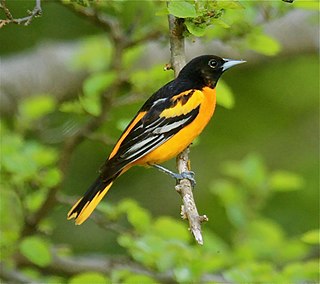
The Baltimore oriole is a small icterid blackbird common in eastern North America as a migratory breeding bird. It received its name from the resemblance of the male's colors to those on the coat-of-arms of 17th-century Lord Baltimore. Observations of interbreeding between the Baltimore oriole and the western Bullock's oriole Icterus bullockii, led to both being classified as a single species, called the northern oriole, from 1973 to 1995. Research by James Rising, a professor of zoology at the University of Toronto, and others showed that the two birds actually did not interbreed significantly.

Bullock's oriole is a small New World blackbird. At one time, this species and the Baltimore oriole were considered to be a single species, the northern oriole. This bird is named after William Bullock, an English amateur naturalist.

The orchard oriole is the smallest species of icterid. The subspecies of the Caribbean coast of Mexico, I. s. fuertesi, is sometimes considered a separate species, the ochre oriole or Fuertes's oriole.

The hooded oriole is a medium-sized New World oriole. The male of this species ranges in color from a bright orange to a paler yellow, with a black back, face, tail and bib, with the wing containing two white bars. The female is more of an olive color with some yellow accents.

New World orioles are a group of birds in the genus Icterus of the blackbird family. Unrelated to Old World orioles of the family Oriolidae, they are strikingly similar in size, diet, behavior, and strongly contrasting plumage. As a result, the two have been given the same vernacular name.
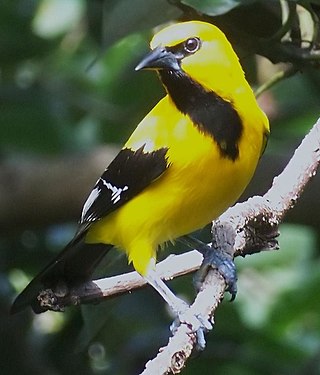
The yellow oriole is a passerine bird in the family Icteridae. It should not be confused with the green oriole, sometimes alternatively called the Australasian yellow oriole, which is an Old World oriole.

The moriche oriole is a passerine bird in the New World family Icteridae. It is unrelated to Old World orioles. It is a breeding resident in the tropics of eastern South America. This bird is noted for its close association with the palm Mauritia flexuosa.
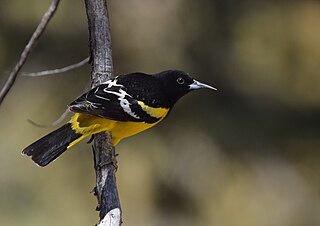
The Scott's oriole is a medium-sized icterid.

The streak-backed oriole is a medium-sized species of passerine bird from the icterid family. It is native to Central America and Mexico and is an occasional visitor to the United States.

The Montserrat oriole is a medium-sized black-and-yellow icterid.

Audubon's oriole, formerly known as the black-headed oriole, is a New World passerine inhabiting the forests and thickets of southeastern Texas and the Mexican coast. It is the only species to have a black hood and yellow body. It is divided into four subspecies and two allopatric breeding ranges. The westernmost range extends from Nayarit south to southern Oaxaca, whereas the eastern range stretches from the lower Rio Grande valley to northern Querétaro. The most common in the western range are the subspecies I. g. dickeyae and I. g. nayaritensis; I. g. graduacauda and I. g. audubonii can be found in the eastern range. Like most Central American birds, it is not a migratory species and does not display significant sexual dimorphism. DNA analysis of the ND2 and cyt-b genes strongly suggests that I. graduacauda is most closely related to I. chrysater, the yellow-backed oriole. It is a member of the genus Icterus and therefore should not be confused with the Old World orioles.

The orange oriole is a small bird species with orange feathers native to the Icteridae family in the Yucatán Peninsula. It has a slender body, long wings, and a pointed beak. Its color resembles the fruit orange, and it has black markings on its wings and tail. The orange oriole is known for its song and can be found in forests and gardens. They have a diverse diet that contributes to their color. According to The Cornell Lab of Ornithology Birds of the World, they have suggested that this species might be better named the “Yucatan Oriole” because they are only found in Southeast Mexico. This species is not endangered and least threatened.

The yellow-backed oriole is a species of bird in the family Icteridae.

The Saint Lucia oriole is a species of bird, in the family Icteridae and genus Icterus. It is endemic to Saint Lucia.
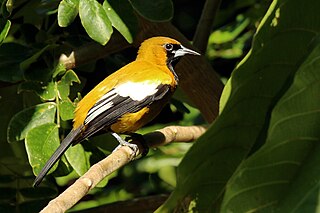
The Jamaican oriole is a species of bird in the family Icteridae.
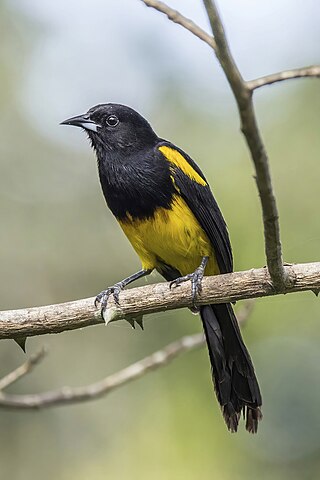
The black-cowled oriole is a species of bird in the family Icteridae. It is common and widespread in the Caribbean lowlands and foothills from southern Mexico to western Panama. It lives primarily in humid or semihumid forest, as well as in clearings, along forest edges, in plantations, in semi-open areas with scattered trees and bushes, and in gardens. The adult male is black, with yellow on the belly, shoulder, rump, wing lining, and crissum. The female's plumage varies depending on location. In the south of its range, it is similar to that of the male. In the north, its crown and upperparts are olive-yellow, while its face, throat, upper breast, wings, and tail are black.
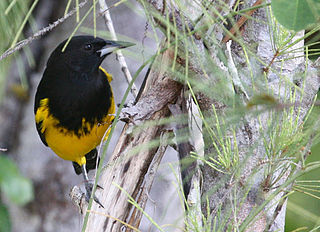
The Bahama oriole is a species of songbird in the New World blackbird family Icteridae. It is endemic to the Bahamas, and listed as endangered by the IUCN Red List.

The Puerto Rican oriole, or calandria is a species of bird in the family Icteridae, and genus Icterus or New World blackbirds. This species is a part of a subgroup of orioles that includes the North American orchard oriole, Icterus spurius, and the hooded oriole, Icterus cucullatus.



















